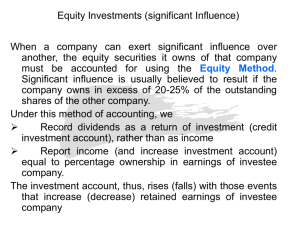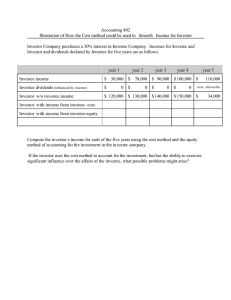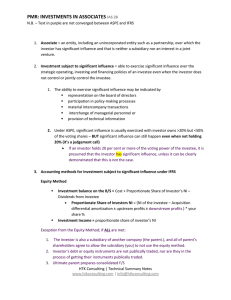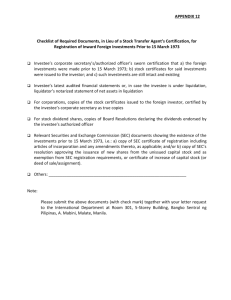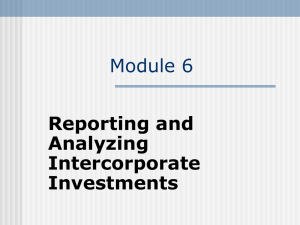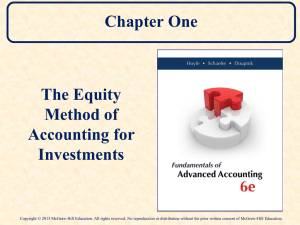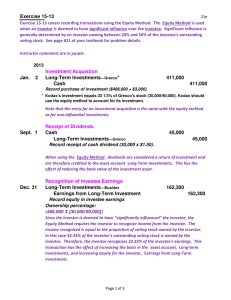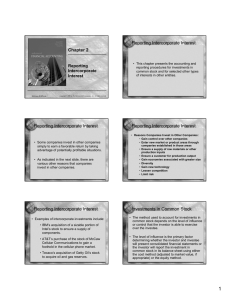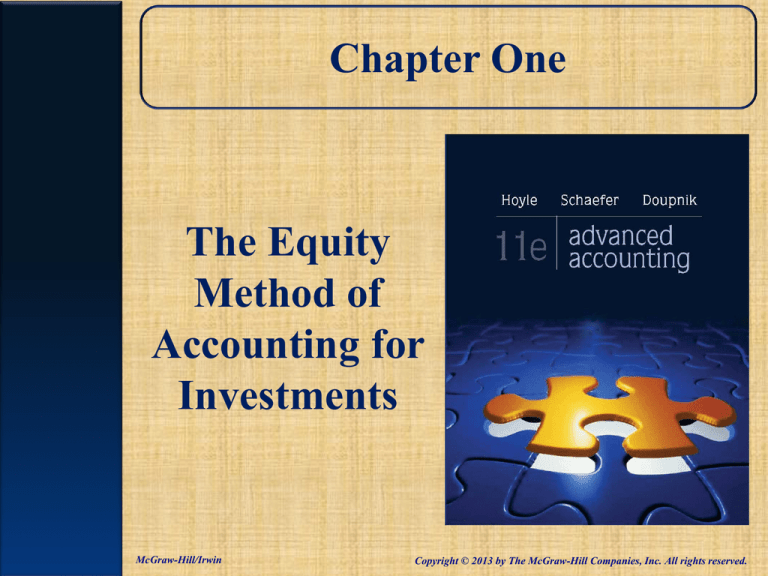
Chapter One
The Equity
Method of
Accounting for
Investments
McGraw-Hill/Irwin
Copyright © 2013 by The McGraw-Hill Companies, Inc. All rights reserved.
LO 1
Accounting for Investments in
Corporate Equity Securities
GAAP recognizes 3 ways to report
investments in other companies:
Fair-Value Method
Consolidation
Equity Method
The method selected depends upon the degree
of influence the investor has over the investee.
1-2
1-3
Fair Value Method
Investments in equity securities are recorded at cost
and subsequently adjusted to fair value.
Investments classified as Trading Securities:
Held for sale in the short term.
Unrealized holding gains and losses are included in
earnings (net income).
Investments classified as Available-for-Sale
Securities:
Any Securities not classified as Trading.
Unrealized holding gains and losses are reported in
shareholders’ equity as other comprehensive income
(i. e., not included in net income).
1-3
1-4
Consolidation of
Financial Statements
Required when:
• Investor’s ownership exceeds 50% of
investee
•
except when control does not rest with
the majority investor
• One set of financial statements prepared
to consolidate all accounts of the parent
company and all of its controlled subsidiaries
AS A SINGLE ENTITY.
1-4
1-5
LO 2
Equity Method
Use when:
• Investor has the ability to exercise
significant influence on the
investee operations (whether influence is
applied or not)
• Generally used when ownership is
• between 20% and 50%.
• Significant Influence might be present
with much lower ownership percentages.
1-5
1-6
International Standard 28
Investment in Associates
The International Accounting Standards Board (IASB),
similar to FASB, defines “significant influence” as the
power to participate in the financial and operating
policy decisions of the investee, but it is not control or
joint control over those policies.
If investor has 20% or more ownership, it is presumed
to have significant influence, unless it is demonstrated
not to be the case.
If investor holds less than 20% ownership, it is
presumed it does not have significant influence, unless
influence can be clearly demonstrated.
1-6
General Ownership Guidelines
Investor Ownership of the Investee’s Shares
Outstanding
Fair Value
0%
Consolidated Financial
Statements
Equity Method
20%
Usually lack
of control or
significant
influence.
50%
Significant influence
generally assumed
(20% to 50%
ownership).
100%
Financial statements
of all related
companies must be
consolidated.
1-7
LO 3
General Reporting Guidelines
Fair
Value
1. Investor
records
investment at
“cost”.
2. Investor
recognizes cash
dividends from
investee as
income.
Equity
Method
1: Same as Fair Value
2: Investor recognizes
its share (% of ownership) of investee’s net
income (net loss) as an
increase (decrease) in
the investment
account and dividends
as a decrease.
Consolidated
Financial
Statements
One set of financial
statements are
prepared to combine
accounts of the
investor and all of
its investees AS A
SINGLE ENTITY.
1-8
1-9
Special Procedures
for Special Situations
Reporting a
change to the
equity
method.
Reporting
investee
losses.
Reporting investee
income from sources
other than
continuing
operations.
Reporting the sale of
an equity investment.
1-9
1-10
LO 4
Excess of Cost Over Book Value
of Acquired Investment
When Cost > Book Value of an investment
acquired, the difference must be identified.
Assets may be undervalued because:
1.Fair values (FV) of some assets and liabilities on
investee’s books are different than book values (BV).
2.Investor is willing to pay extra expecting future
benefits to accrue from the investment.
3.Additional amount paid in excess of book value not
allocated to undervalued assets is attributed to an
intangible future value and recorded as Goodwill.
1-10
LO 5
Reporting Sale of Equity Investment
If part of an investment is sold during the period:
The equity method continues to be applied up to
the date of the transaction.
At the transaction date, the Investment account
balance is reduced by the percentage of shares sold.
If significant influence is lost, NO RETROACTIVE
ADJUSTMENT is recorded, but the equity method
is no longer applied.
1-11
1-12
LO 6
Unrealized Profits in Inventory
Sometimes affiliated companies sell or buy
inventory from each other in intra-entity
transactions that necessitate special
accounting procedures.
INVESTOR
Downstream
Sale
INVESTEE
INVESTOR
Upstream
Sale
INVESTEE
1-12
LO 7
Fair Value Reporting Option
In 2007, FASB introduced a fair-value option
An entity may irrevocably elect fair value as the
initial and subsequent measurement for certain
financial assets and financial liabilities including
investments accounted for under the equity method.
Under the fair-value option, changes in the fair value
of the elected financial items are included in
earnings.
1-13
Fair Value Option
Investment that
can otherwise be
accounted for
under the equity
method
Investment in nonmarketable equity
securities
After 2007, under the Fair-value Option,
changes in the fair value of these assets are
reported in earnings.
1-14

